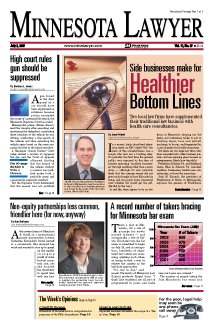The filing period for judicial elections (and, of course, other state elections as well) starts in about six weeks. Candidates must file with the Secretary of State between July 1 and 15. But campaign season appears to have already begun -- at least for the two Minnesota Supreme Court justices up for election this year.
As we mentioned
in a post Friday, Justices Paul Anderson and Lorie Gildea -- the two members of the high court whose names will appear on the 2008 ballot -- have taken visible public roles in this week's Sesquicentennial festivities. Anderson will be impersonating a 19th century high court justices at various events; Gildea not only is portraying the state's first justice (who happens to have been, not surprisingly for the time, a man), but also is taking on a second role portraying the state's first woman lawyer. In the spirit of the first role, she even agreed to ride a horse.
Now, I can't say for sure there is an election tie in. For example, I have little doubt that Anderson -- who is well-known as a court history buff and as the high court's goodwill ambassador at public events -- would not have to be asked twice to be a part of something like this. And perhaps Gildea has always wanted to ride a horse in period costume during a parade, for all I know. But there is little doubt that these public platforms afford the justices an opportunity to be seen by John (and Jane) Q. Public, who don't often get over to the Minnesota Judicial Center to see the high court in action.
Even putting election-year politicking aside, it's no secret that the state high court has increased its community outreach efforts substantially over recent years. Former Chief Justice Kathleen Blatz made this a priority as part of the courts' efforts to educate the public on its role -- and Chief Justice Russell Anderson has continued those efforts. Outreach efforts have included holding oral arguments "on the road" in locations throughout the state, including high schools and law schools. (Hopkins High School last week hosted an oral argument, for example.)
The efficacy of the outreach efforts is difficult to quantify -- and, despite all past efforts, the judiciary remains by far the most misunderstood branch of government. Nonetheless, I think that it's an important part of the judicial function to at least
try to bring a better understanding to the general public. While donning ancient jurist garb and riding a horse or strolling around the Capitol grounds may on its face have limited utility in fulfilling this function, a few folks may just get curious enough to start boning up on these robe-clad individuals who make up a third of their government. If it does that, I suppose wearing cowboy boots is a small price for a justice to pay ...
 The wrangling over the top judicial spot in Ramsey County has come to an end.
The wrangling over the top judicial spot in Ramsey County has come to an end.
